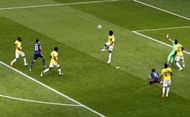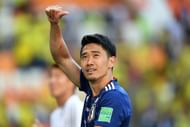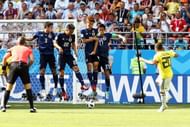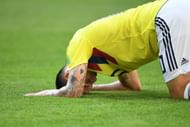Japan scripted history today by becoming the first Asian team to have defeated a South American nation in the FIFA World Cup. Akira Nishino’s team managed to sneak a minor opening from a majorly resilient Colombian defence as Yuya Osako headed in the winning goal in the 73rd minute through a corner from Keisuke Honda.
Colombia disappointed collectively, as Radamel Falcao was deprived of quality service for the majority of the game. Jose Pekerman’s men suffered a numerical disadvantage on the field as Carlos Sanchez’s early sending off meant that the team had to play for almost ninety minutes with just 10 players on the field.
This certainly had a huge negative impact on them, considering the fact that the team was forced to undertake a pragmatic approach afterward. This was an interesting game from another perspective too, that is, the fact that none of the three goals came from open play.
One penalty, a free-kick, and then a corner-kick is what decided the fortunes of this game, with both the teams putting in incredible work-rate and commitment, which was quite visible through the speed of the build-up play and some slick counter-attacks that Japan initiated. Here, we look at five players who underwent contrasting experiences in the game.
To put it in a more understandable way, here, in the next five slides, I state my opinions on the best and the worst players from the 28 players who stepped on the field during this contest.
#1 Worst: Carlos Sanchez

It would be a tad bit weird to term a player negatively who barely spent five minutes on the field. However, it was Carlos’ lack of match-awareness and a comical moment of madness that resulted in Colombia playing the catch-up game for the entirety of the match.
Sanchez deliberately blocked a long-range effort, directed straight at the goal with his hands and subsequently gave away a spot-kick to Japan.
His handling of the ball also meant that he was sent off in the second minute itself. It is actually the second fastest red card issued in the World Cup history. Moreover, Colombia were mentally and psychologically hurt by this and were forced to change their overall playing style too.
Carlos was expected to anchor the midfield, feed through-balls to Falcao and to induce some creativity coupled with energy and drive at the centre of the park.
In his absence, Colombia were forced to play long balls from wide areas to Falcao, whose overall influence in the game degraded to a huge extent too.
Without James and Carlos, Colombia looked bleak and were overrun in the midfield; and, Sanchez should take up a whole lot of responsibility for his stupid error which led to all of this.
#2 Best: Shinji Kagawa

While Colombia lacked numbers and creativity in the middle, Japan were fortunate to have the services of the ever so dependable Shinji Kagawa in an attacking midfield position.
Kagawa brought in a sense of calming influence to the game, often maintaining the possession of the ball, making the right passes, and moving accurately in order to receive the return pass.
His one-touch passing display bamboozled the Colombian defenders, who were often drawn out of their positions with some immaculate movement by Shinji.
The Borussia Dortmund player slid in some smart through balls for the forwards, and often shifted out wide to utilize the width of the pitch.
He was all around the attacking positions, getting into the gaps created by the Colombian midfielders and making the required, accurate pass almost every single time.
His agility on the field and the composure and assurance with the ball ensured that Japan pegged Colombia back in the first 25 minutes of the second half.
Kagawa’s temperament was best visible when he patiently waited for David Ospina to dive before slotting in his spot-kick right through the centre. The experience and calm-head that he carried helped Japan a lot, and Kagawa would an instrumental member in their squad going further in the tournament.
#3 Best: Juan Quintero

Juan was deployed behind Falcao and was expected to play the role of a proper playmaker, i.e. to split apart the opposition defence with through-balls, to play lobbed balls into the box and to distribute the ball to the flanks in order to spread the attacking play.
However, Colombia rarely seemed to play through the centre, as Sanchez’s sending off resulted in Quintero being asked to pounce on the second balls headed by Falcao. These long balls were initiated from the Colombian backline in order to avoid being outnumbered at the centre of the park.
Quintero used his acceleration and footwork to good effect as he looked to push ahead along with Falcao, but Japan’s astute defensive positioning negated this aspect of Quintero’s game too. So, when all the pathways to the goal were closed down, Juan stepped up to take a free-kick a bit far away from the box from a good enough angle.
Being a left-footed player, many believed that Quintero would have targeted the top right corner. However, with a cool demeanor, Quintero waited for the wall of players to jump in unison before he slotted the ball perfectly from the bottom, at a good pace and it entwined further to avoid Ejji Kawashima’s gloves too.
It was the definition, the epitome of swagger, as Quintero provided a ray of hope to bounce back in the game for the Colombians.
#4 Worst: James Rodriguez

Many Colombian fans had traveled a long distance to witness their star, James Rodriguez in action. The Golden Boot winning breakthrough player from the last World Cup, James has been touted to lead Colombia’s charge this time around.
However, the team were hit with a major blow when James was diagnosed with a muscle issue on his calf and that effectively ruled him out from a starting spot.
Rodriguez is extremely crucial to Colombia’s style of play, as his passing range coupled with a knack for scoring regular goals means that he exudes a lot of offensive creativity and flair to their game.
After coming from the bench post the one-hour mark, Rodriguez looked a bit rusty and didn’t settle into the game quickly enough. His off the ball contribution wasn’t the best either, something that was needed as Colombia were required to collectively defend in order to cover up for Sanchez’s place.
Moreover, he was required to provide some spark in the final third so that Columbia could have looked for another goal. His introduction did not yield any noticeable impact; as James was left with chasing the ball for most of his stay on the pitch.
There was always some timely clearance, and Rodriguez should have been swifter in order to create some goal-scoring opportunities for the isolated Radamel Falcao.
To cap it off, James also received a yellow card for a rash challenge in the final ten minutes of the game. This now puts extra pressure on him to not commit any more punishable fouls, as that would risk his involvement in the further games.
#5 Best: Yuya Osako

Japan and mostly Asian teams have to deal with the height disadvantage over the other football playing countries. The average height of this Japanese team was almost 4 centimeters shorter than their Colombian counterparts. Still, the winner came through a headed attempt from Yuyo Osako.
Osako was a livewire on the field, as his incessant energy and determination to win the ball back meant that Japan’s first line of defence was strong enough to regain possession.
Yuya, despite playing as the sole striker upfront, made it sure that he regularly dropped to the midfield in order to orchestrate the passing moves in a more cohesive manner. His understanding with Kagawa was quite visible, as both of them made the required, accurate movements whenever Japan went on an attacking mode.
Osako shifted all across the forward line, further demonstrating his tendency and tenacity to spot and accordingly attack at the holes in the opposition’s backline. He tracked back during set-pieces and carried the ball along with him in the counter-attacks.
Most importantly, Yuya’s jump and accuracy of the header that eventually resulted in a victory for Japan is a pure display of strong resolve and commitment towards getting his team over the finishing line.
